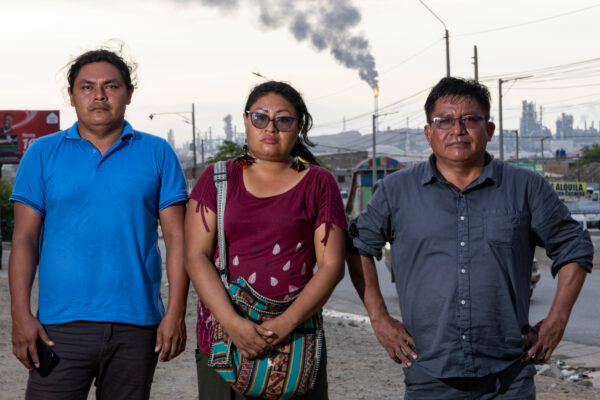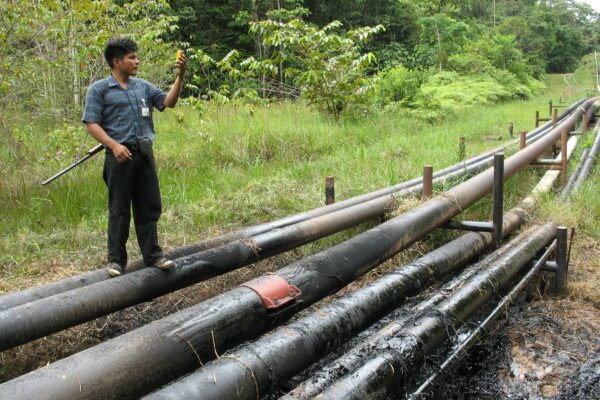A year has passed since a police operation to end 55 days of peaceful indigenous protests in the Amazon basin resulted in a violent clash between military police and peaceful indigenous protesters in Bagua last June 5, 2009. It was the worst violence Peru has seen in recent history, leaving 34 people dead and almost two hundred injured. One year later there is a troubling divide between indigenous leaders, seeking reconciliation and clear answers about what happened, and a government intent on denying all responsibility and criminalizing indigenous protesters with unfounded legal charges.
Sadly, the government’s discourse has not changed much since the Ministry of the Interior’s public service announcement broadcast on television in the days following the clashes to portray indigenous peoples as savage extremists, tricked by foreign infiltrators to think the government was trying to take their land. In his recent public address on the one-year anniversary of the clashes, Peruvian President Alan Garcia characterized the incident as an ambush and brutal massacre of police by indigenous extremists armed for war. Unfortunately, these inaccurate and inflammatory statements only serve to demonstrate that the Peruvian government has yet to learn the true lessons of Bagua.
Meanwhile, in Bagua, at the site of the bloody clashes, the contrast with the government’s polemical rhetoric could not have been greater. Indigenous people were joined by environmental youth groups and local townspeople in a peaceful march of remembrance and reflection. Standing in vigil that night, holding candles, indigenous leaders called for justice, reparation, reconciliation and peace. Rather than anger at police, there were shared tears and condolences for fellow Peruvians simply following orders.
One wishes that the government would show the same wisdom and maturity in addressing both this tragic history and the tension still dominating its relations with indigenous peoples.
Indigenous leaders are frustrated that at a time when the country desperately needs reconciliation and impartial investigation into what happened, the government continues to demonstrate a dangerous lack of good faith by fomenting division and hatred of indigenous peoples, and refusing to accept any responsibility for its central role in this tragedy. Leaders are tentatively hopeful about a new law recently approved by the Peruvian congress which would guarantee indigenous peoples’ right to consultation on projects that affect them. It is a far cry from the consensus proposal prepared by indigenous groups, civil society and the Peruvian Ombudsman office, but if signed into law by the President it would be a small but important step forward. However, in an example of the “one step forward, two steps back” dynamic that has characterized progress with the current administration, the government’s hydrocarbon licensing arm recently opened a bidding round for 24 new oil blocks that overlap indigenous territories in the Amazon, which brings the total percentage of the Peruvian Amazon targeted for oil and gas exploration to 72%.
Little progress has been made in identifying who is responsible for the peaceful protests turning to bloodshed last year, despite continued calls by Peruvian and international human rights groups for a real investigation and an end to the continued threats against indigenous peoples in Peru. The government maintains that it shares no responsibility, and that national indigenous leader Alberto Pizango bears sole responsibility for inciting violence, despite clear evidence to the contrary. The government’s entire case rests upon a press conference when Pizango informed the press that protest leaders were invoking their constitutional right to insurgencia (civil disobedience) in the face of the government’s declaration of a state of emergency to clamp down on the protests. Pizango publicly withdrew the call for insurgencia the following day, nearly three weeks before the violent clashes took place.
Garcia objects that police deaths have not been investigated with the same urgency as civilian deaths, which is patently false since there have been no investigations at all into civilian deaths. All court proceedings to date have focused on identifying indigenous people as responsible for killing police. The criminal proceedings to date are widely recognized as a political farce. The government appears to be using politically motivated criminal prosecutions against indigenous leaders in an attempt to assign responsibility to anyone other than government officials and use the incident to criminalize legitimate social protest and destabilize the indigenous movement. Charges have been bought seemingly at random against leaders and indigenous people who just happened to be present, and over one hundred protesters were immediately detained with no evidence against them. The government has issued capture orders against a large number of indigenous leaders, some of whom were not even present during the clashes, and has not provided the accused with due process or an opportunity to defend themselves against the charges. To date there still have been no criminal proceedings against any police or the government officials who ordered the use of force for the civilian dead or injured.
For progress to be made and the wounds to heal, the government needs to answer some key questions.
First, why, on June 4th, the day before the clashes, did the Peruvian congress for a third time postpone the debate of the controversial decrees that were the focus of the protests, which both a multi-party commission and constitutional commission had already found to be unconstitutional?
Second, why were the police sent to clear the road at the Devil’s Curve outside Bagua on June 5th when it was widely known the protesters had already reached an agreement to leave voluntarily that day? On the evening of June 4th, local police chiefs met with indigenous leaders and explained they had orders to clear the road. Protesters agreed with the police that they would peacefully lift the roadblock at 10:30am the next morning, yet a group of heavily armed police approached the protesters, some of whom were still sleeping, before dawn on the morning of June 5th, and set off the violence.
Third, who gave the order for an operation to clear a roadblock and peaceful protest with a pre-dawn raid carried out by a squadron of police armed with AK-47s, and who gave the order for the police to fire on thousands of unarmed civilians? Photographs and video footage of the clashes demonstrates that protesters were armed, if at all, only with symbolic wooden spears. Yet 208 automatic weapons fired 24,900 bullets that morning, and forensic analysis of all the protesters arrested that day has demonstrated that none of them had fired weapons.
Finally, the government needs to recognize its obligation to respect indigenous peoples’ rights. The government continues to refer to ignorant protesters tricked by foreign agitators into thinking the government was trying to take their land, despite the abundance of information supporting the legitimacy of the protesters’ position. The minority report produced by a subset of the commission charged with investigating the clashes lists fifteen texts by various experts that outline the legal implications of the decrees at the heart of the protest on indigenous peoples’ rights. Most of the protesters were responding to very real and immediate threats to their territories and ways of life: oil and mining companies moving into their hunting and fishing grounds, sacred places and ancestral homes, and preparing to exploit the resources of the Amazon for the short-term financial gain of a few.
It is unjustifiable that a year after the tragic clashes in Bagua, indigenous people in Peru still face continued attacks by the Peruvian government against their rights. They have the right to determine their own future, and the Peruvian government needs to recognize its obligation to support and respect their right to self-determination.













